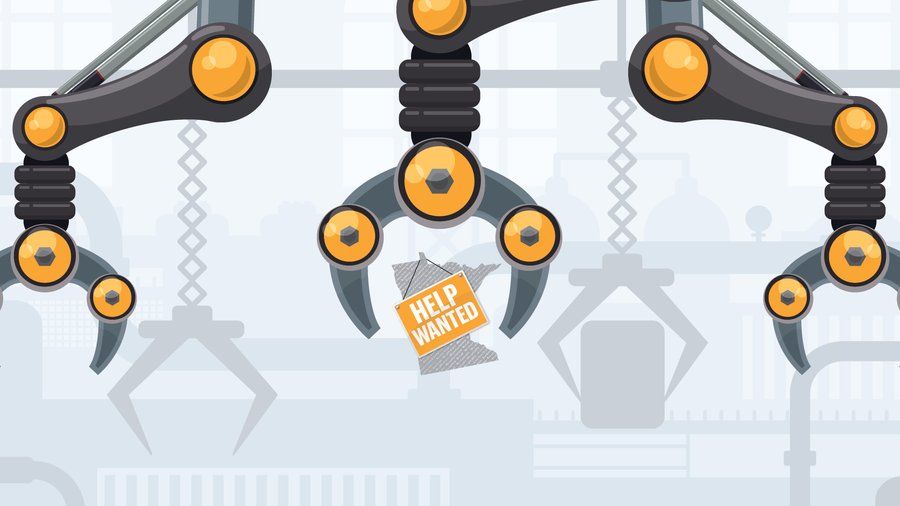In half a century, Monticello-based Ultra Machining Co. Inc. has grown from its founder’s garage to a 72,000-square-foot, state-of-the-art manufacturing facility. Supplying the medical-device and aerospace industries with complex, often tiny components requires a team of workers with specialized skills, including certified machinists.
Those machinists are in short supply these days, so within the past six months UMC has started pairing them with operators who have the mechanical aptitude and drive to advance but don’t yet have a two-year degree. The pairs work more efficiently together — the machinist can focus on higher-level tasks while the operator tends the machine — and the operator gains skills and experience that could eventually lead to a career as a machinist.
Jaci Dukowitz, the company’s chief operating officer, said it can be intimidating to break into the increasingly complex and technologically demanding field of manufacturing, especially the type of precision machining that UMC has made its specialty.
“We wanted to break down some of those barriers,” she said. “This gets you in, gets you exposed.”
And it may help UMC combat a worker shortage that is plaguing manufacturers across the state, one that could leave it short an estimated 7,000 workers by 2022. It’s the top concern for Minnesota manufacturers, according to a survey consulting organization Enterprise Minnesota conducted this spring.
RELATED: Q&A with Jaci Dukowitz, chief operating officer of Ultra Machining
Four hundred manufacturing executives were asked to name the one or two biggest challenges to the growth of their businesses. Attracting and retaining a qualified workforce came up in nearly half of all responses — more than the cost of health insurance or rising prices for energy and materials.
“While this survey was done in March of this year, the issues have not changed. If anything, they’re becoming more magnified,” said Lynn Shelton, vice president of marketing for Enterprise Minnesota. “… They’re screaming for workers.”
The manufacturing sector accounts for nearly 11 percent of all jobs in the state, or more than 342,000 workers, according to RealTime Talent, a public-private collaborative assembled to take on the state’s workforce challenges. But research strategist Erin Olson said its share of the workforce pie is projected to shrink in the next three years unless manufacturers can fill entry-level positions and equip workers with the degrees and certificates they need to advance.
Manufacturers are responding with a variety of tactics, including in-house training programs and partnerships with technical schools. They’re leveraging automation to boost productivity while sweetening their benefits to attract more workers.
UMC is projecting double-digit revenue growth next year, and Dukowitz said the company would add 40 to 50 employees — if it could find them.
“It definitely inhibits our ability to grow,” she said.




Monticello-based Ultra Machining Co. Inc. supplies the medical-device and aerospace industries with complex, often tiny components requires a team of workers with specialized skills, including certified machinists.
Changing skills
Maple Plain-based Proto Labs Inc. specializes in on-demand and rapid production, quickly manufacturing prototypes for product developers around the world using a variety of technologies, including 3D printing, injection molding, computer-controlled machining and sheet metal fabrication. The company is working on the digital frontier of manufacturing, known as industry 4.0, using smart, interconnected machines to optimize performance at Proto Labs’ eight U.S. plants, including facilities in Rosemount, Plymouth and Brooklyn Park.
The skills needed to work in industry 4.0 are changing so fast that schools are struggling to keep up, said Renee Conklin, vice president for human resources at Proto Labs. The company has about 1,300 employees in Minnesota and roughly 800 of them are directly involved in manufacturing, including molding technicians who have gone through a two-year certification program.
“A lot of people that we employ have those types of skill sets and backgrounds; [schools] are just not producing enough of them,” Conklin said.

And it’s not just technical skills and work ethic that manufacturers like Proto Labs are seeking in potential hires. In a complex, high-tech environment, they need strong communicators who, at the end of their shifts, can successfully pass the baton to the next crew.
Dunwoody College of Technology President Rich Wagner said advances in manufacturing — including automation and smart-sensor technology — are revolutionizing not just the industry but the schools like Dunwoody that train its workforce. Industry 4.0 is placing an emphasis on computer and networking skills, and at Dunwoody that means there’s a lot more “cross-curriculum conversation” between its manufacturing and computer-technology departments.
RELATED: Q&A with Dunwoody College of Technology President Rich Wagner
And yet the industry is still saddled with the stigma that it’s dirty, hard work that doesn’t require much brainpower. It’s a viewpoint prevalent “not so much with the students as the key influencers,” Wagner said, meaning the parents who cling to the idea that a four-year degree is the only path to good pay and career satisfaction.
The middle and high school students enticed to explore manufacturing careers through industry-sponsored robotics competitions? They get it, Wagner said. Manufacturing has changed.
Career pathways
Plymouth-based Daikin Applied is a quickly expanding manufacturer of HVAC systems with plants in Faribault and Owatonna. It has a workforce of about 1,000 people between the two factories, including 800 on the factory floor, and it plans to add roughly 300 workers in the next five years, said Senior Human Resources Director Matt Alexejun.
The company prefers candidates with manufacturing experience, but hard workers with a high school diploma can excel, too, Alexejun said. Daikin runs a robust in-house training program in learning centers inside its factories dubbed “dojos,” the term adopted by its Japanese parent company.
Employees learn a variety of skills inside the dojos, including fabrication, wiring, assembly and copper brazing. They can even go to international competitions against brazers from Daikin’s 90 production bases around the world.
“This is a career pathway opportunity,” Alexejun said.
Graco Inc., a Minneapolis-based manufacturer of fluid-handling equipment, took proactive measures to get ahead of the workforce pinch. Executive Vice President of Operations Angie Wordell said the company formed partnerships with area tech schools several years ago to help boost its supply of certified CNC machinists, which, along with assembly workers, is its largest pool of workers.
“We work with [schools] on bringing in CNC students and having them work as interns at Graco. And then … we’ve also created a training program inside of Graco, so when they graduate we can continue to train them and get them up to speed on our equipment, and we can continue to retain them,” Wordell said.
Another way Graco works to retain employees is by creating career pathways within the company. Workers without a degree are encouraged to go back to school — with tuition assistance from Graco — and those with a certification get support to advance, for instance, from machining to a manufacturing-engineering position, or from assembly to electrical assembly.
“We try and encourage people to look at not just the job they’re hired for, but other jobs they can move up into through the company. And if we can support them through education or cross-functional training, we try to do that,” Wordell said.
Even though many manufacturers offer similar opportunities — educational benefits and in-house training that will boost workers’ skills and wages — they’ve struggled to communicate them to potential workers, said Peg Thomas, executive director of St. Paul-based Sundance Family Foundation. The foundation’s Wunderkammer program puts students in contact with manufacturing workers and their tools, a hands-on experience that aims to pique their interest in the industry’s career possibilities.
“If you’ve never put together a thermostat, why would you know you want to put together thermostats?” Thomas asked.
Sundance organizes tours that introduce students to employers in the industry, and Thomas recalled a recent visit to Graco with students from nearby North Minneapolis neighborhoods.
“It was like someone pulled a veil,” she said. “It was just a big space they’d driven past 1,000 times. They had no idea what it was, and they certainly had no idea they could work there.”
Automating for efficiency
Once inside the plant, those students would have seen a manufacturing floor where flesh-and-blood workers are doing their jobs alongside an increasing number of robots.
Wordell of Graco said automation can help companies like hers manage a workforce shortage, but it can’t replace workers. Automation is about using people more effectively, she said.
“We can actually have the automation or the higher-technology equipment do more of the mundane things and then use our operators, our people, to do more of the stuff that a robot can’t do or is hard to train them to do,” she said.
Dukowitz of UMC said robots have been supplementing the workforce at their plant for decades. They often do the kind of boring, repetitive pick-and-place work, allowing human workers to focus on trouble-shooting and other jobs that require intelligence, not just force.
“[Automation] can’t completely replace workers,” she said. “That’s never going to happen for us.”
However, it can make them more efficient. One worker paired with robots can oversee three UMC manufacturing cells, and the company has one fully automated cell that can run unattended for 20 hours.
Automation is reshaping UMC’s workforce in other ways, requiring the company to add engineers dedicated to acquiring and programming robots. And it requires machinists who are “bigger thinkers,” who can see how robots fit into their processes and work with engineers to make them ever more efficient, Dukowitz said.
Dunwoody’s Wagner said automation requires participants in the manufacturing workforce to become life-long learners, able to adapt to advances in technology. Inevitably, innovations in automation and robotics will displace some workers, he said, but it also creates new opportunities for workers who understand how to work with robots, sensors and the information they produce.
Learning to be flexible
As they compete against each other and the Amazon warehouse down the road for employees, many manufacturers are responding to worker scarcity by boosting wages and benefits. And flexible scheduling is another important piece to the recruitment and retention puzzle.
Alexejun of Daikin said younger workers, in particular, need and expect that type of flexibility to accommodate their ongoing education or family time. Daikin runs a three-days-on, four-days-off schedule on its first and second shifts, and within the past three or four years it’s added a weekend shift to appeal to students.
After purchasing Warrior Mfg. with his brother in 2002, CEO Paul Soukup accelerated the growth of the company in part by promising customers a quick turnaround on their orders. Hutchinson-based Warrior designs and fabricates steel structures used in a variety of industries, but mainly agriculture.
“When I got into the business, customers asked about lead times,” Soukup said. “I said, ‘What are lead times? When do you need it?’”

It’s a nose-to-the-grindstone business ethic that requires buy-in from Soukup’s workforce of welders and fabricators, who skew millennial demographically. They regularly work overtime to meet deadlines, but in June, Soukup adjusted the schedule so that after four days of 10-hour shifts, they come in for just a half day on Fridays. It was a compromise that acknowledged his workers’ desire for flexibility and free time.
“Once we did that, we have — knock on wood — lost very few people,” he said.
It’s not only boosting retention at a time when low unemployment means workers have plenty of options, but also morale. Now, when they leave work after a half-day shift on Friday, a whole group of Warrior employees meets up for lunch at a Hutchinson restaurant.
“I’m in downtown Hutchinson, out to lunch, not long after that, and here they are, piling in, a whole crew of them, which they didn’t used to do,” Soukup said.
| Rank | Prior Rank | Name |
|---|---|---|
1 | 1 | Cargill Inc. |
2 | 2 | 3M Co. |
3 | 3 | Medtronic |



